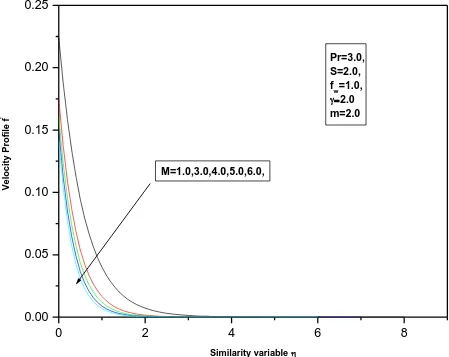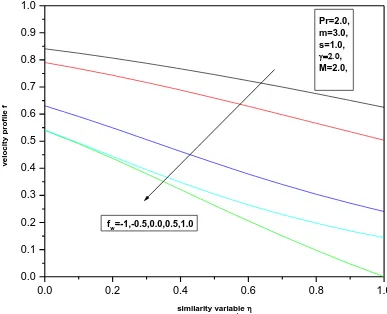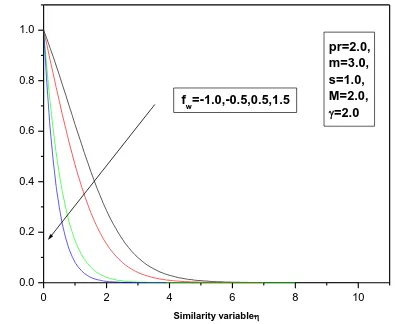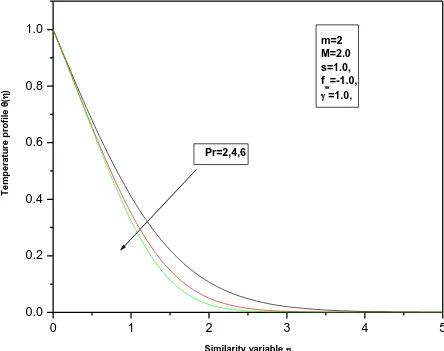© Associated Asia Research Foundation (AARF)
A Monthly Double-Blind Peer Reviewed Refereed Open Access International e-Journal - Included in the International Serial Directories.
Page | 77
MHD BOUNDARY LAYER VISCOUS INCOMPRESSIBLE FLUID
FLOW AND HEAT TRANSFER OVER A NONLINEAR STRETCHING
SURFACE WITH VARIABLE SURFACE TEMPERATURE AND
PARTIAL SLIP
Noorjahan
Department of Mathematics, Dravidian University, Kuppam-517425, Andhra Pradesh, India
ABSTRACT
The present study concerns to boundary layer viscous fluid flow and heat transfer over a
nonlinear stretching surface with the effect of variable surface temperature, partial slip, and
magnetic field.The governing boundary value problem,consisting of a set of nonlinear
partial differential equations are transformed into a set of nonlinear ordinary differential
equations and are solved using Runge-Kutta fourth order method.The Effects of various flow
and heat transfer charecteristics are analysed and the results are suitably interpreted
graphically.
KEYWORDS: Viscous incompressible fluid;Nonlinear stretching surface;MHD;boundary
layer;Variable surface temperature;Partial slip.
I INTTRODUCTION
Sakiadis [1], was the first to investigate the boundary layer flow past a moving solid surface of a viscous fluid with a constant velocity. Later, the numerical results of Sakiadis [1] were confirmed by Tsou et al. [2] analytically and experimentally.In recent years,
the flow and heat transfer over a stretching sheet immersed in a Newtonian fluid in the presence of magnetic field has received great attention because of its important applications in metallurgical industry which involves the cooling of continuous strips and filaments drawn through a quiescent fluid. The problem of flow and heat transfer over stretching surface find applications to polymer technology, where one deals with stretching of
International Research Journal of Natural and Applied Sciences
ISSN: (2349-4077) Impact Factor- 5.46, Volume 5, Issue 4, April 2018 Website- www.aarf.asia, Email : editor@aarf.asia , editoraarf@gmail.com
© Associated Asia Research Foundation (AARF)
A Monthly Double-Blind Peer Reviewed Refereed Open Access International e-Journal - Included in the International Serial Directories.
Page | 78
plastic sheets. In particular , many metallurgical processes invove cooling of continuos strips or filaments by drawing them through a quiscent fluid and that in process of drawing, these strips are sometimes stretched.In the case of annealing and thinning of copper wires, the properties of the final product depend to a great extent on the rate of cooling. In view of such applications a problem of this kind is considered in this present work. The process of suction and injection has also its importance in many engineering applications such as the design of thrust bearing, radial diffusers and thermal oil recovery. Blowing is used to add reactants, cool the surfaces, prevent corrosion or scaling and reduce the drag, Labropulu etal[3]
The problem of non-linear stretching sheet for different cases of fluid flow has also been analyzed by different researchers. Vajravelu [4]examined fluid flow over a nonlinearly stretching sheet. Cortell [5] has worked on viscous flow and heat transfer over a non-linearly stretching sheet. Cortell [6] further investigated on the effects of viscous dissipation and radiation on the thermal boundary layer, over a non-linearly stretching sheet. Raptis et al [7] studied viscous flow over a non-linear stretching sheet in the presence of a chemical reaction and magnetic field. Abbas and Hayat [8] addressed the radiation effects on MHD flow due to a stretching sheet in porous space. Cortell [9] investigated the influence of similarity solution for flow and heat transfer of a quiescent fluid over a non-linear stretching surface. Awang and Kechil [10] obtained the series solution for flow over nonlinearly stretching sheet with chemical reaction and magnetic field.
The no slip boundary condition( the assumption that a liquid adheres to a solid boundary) is one of the central tenets of the Navier Stokes theory. However, there are situations wherein this condition does not hold.The inadequacy of the no slip condition is evident for most Newtonian as well as non-Newtonian fluids.For,example, polymer melts often exhibit macroscopic wall slip and that in general is governed by a nonlinear and monotone relation between the slip velocity and the traction.This may be important in shear skin, spurt and hysterisis effects, and also the fluids which exhibit slip boundary condition have important technological applications such as in the polishing of artificial heart valves and internal cavities. Navier[11] proposed a slip boundary condition wherein the slip depends linearly on shear stress.
© Associated Asia Research Foundation (AARF)
A Monthly Double-Blind Peer Reviewed Refereed Open Access International e-Journal - Included in the International Serial Directories.
Page | 79
the traditional flow .For the fow in the slip regime,the fluid motion still obeys the Navier Stokes equations,but with slip velocity or temperature boundary conditions.
In addition, Partial velocity slip may occur on the stretching boundary when the field is particulate such as emulsions, suspensions, foams and polymer solutions.
In certain cases, partial slip between the fluid and the moving surface may occur. Examples include situations when the fluid is particulate such as emulsions, suspensions, foams and polymer solutions. Also the extrudate may be rough or porous where the no slip condition is considered. In these cases the proper boundary condition is well described by Navier’s condition.
All the investigators restricted their analysis to viscous/visco-elastic flow over a linear stretching sheet. However, the intricate problem of flow and heat transfer over non-linear stretching sheet with the effects of buoyancy and partial slip is yet to be studied. This has several industrial applications. Hence the present paper aims in the investigation of the same. The combined effect of all the above-mentioned parameters has not been reported so far, in the literature, which makes the present problem unique
II Problem formulation
Consider a steady, two-dimensional free convection flow adjacent to a nonlinear stretching vertical sheet immersed in an incompressible electrically conducting viscous fluid of temperature T. The stretching velocity Uw( )x and the surface temperature T xw( ) are assumed to vary linearly with the distance x from the leading edge, i.e. Uw( ) =x axm and
( ) = s
w
T x Tbx , where a and b are constants with a> 0 , b0, and
1 2 ( )
m B x Bx
.
The boundary layer equations of motion and heat transfer are,
= 0,
u v
x y
(1)
2
2
= ( ) ,
u u u
u v B x u
x y y
(2)
2
2
= ,
T T T
u v
x y y
(3) and are subjected to the following boundary conditions
, u mu x y L ax y
, = ( ), , = at = 0, s
w w
© Associated Asia Research Foundation (AARF)
A Monthly Double-Blind Peer Reviewed Refereed Open Access International e-Journal - Included in the International Serial Directories.
Page | 80 Where 1 2 ( 1) ( ) 2 m w w a m
v x f x
0, , as ,
u T T y (4)
where u and v are the velocity components along the xand y axes, respectively. Further, , , , and T, are the dynamic viscosity, fluid density, thermal diffusivity, and fluid temperature in the boundary layer, respectively.
A common feature of all these analyses is the assumption that the flow field obeys the conventional no-slip condition at the sheet that is the velocity component u x y
, parallel with the sheet becomes equal to the sheet velocity axm at the sheet. In certain situations, however, the assumption of no-slip does no longer apply and should be replaced by a partial slip boundary condition which relates the fluid velocity u to the shear rate uy
at the boundary. Here L is the slip length, and y denotes the coordinate perpendicular to the surface. This slip-flow condition was first introduced by C-L.M.H Navier more then a century ago and has more recently been used in studies of fluid flow past permeable walls, slotted plates, rough and coated surfaces, and gas and liquid flow in micro devices. The no-slip boundary condition is known as the central tenets of the Navier-Stokes theory. But there are situations wherein such condition is not appropriate .Especially; no slip condition is inadequate for most non-Newtonian fluids. For example polymer melts often exhibit macroscopic wall slip and that in general is governed by a non-linear and monotone relation between the slip velocity and traction. The fluids exhibiting boundary slip find applications in technology such as in the polishing of artificial heart valves and internal cavities. Navier suggested a slip boundary condition in terms of linear shear stress.
The momentum, and energy equations, (2),(3), and (4) can be transformed into the corresponding nonlinear ordinary differential equations by the following similarity transformation: 1/2 1 2 ( 1) = , 2 m m a x y ( , ) ( ), m
u x y ax f
1 1 2
2
( 1) 1
( , ) ( ) ( )
2 1
m
m a m
v x y x f f
m
(5)
= . w T T T T © Associated Asia Research Foundation (AARF)
A Monthly Double-Blind Peer Reviewed Refereed Open Access International e-Journal - Included in the International Serial Directories.
Page | 81
Where T xw( )Tbxs, b is dimensional constant and n is the index Of power law variation of temperature.
The transformed nonlinear ordinary differential equations are
2
2
= ,
1
m
f ff f Mf
m
(7)
2 2 (1 ) B where M a m 2 = [ ( ) ], 1 r s
P f f
m
(8) Boundary conditions (6.2.4) becomes
0 = w
0 = 1 (0), (0) = 1, ( ) 0, ( ) 0.f f f f f (9)
Where L Re (1x m),
1 Re m x ax ,
III Numerical Solution
The nonlinear boundary value problem represented byEqs.(7) to(9) is solved numerically using Fourth-orderRunge Kutta shooting technique.Making an initial guess for the values of f(0)and(0) to initiate the shooting process is very crucial in this process.The success of the procedure depends very much on how good this guess is. Numerical solutions are obtained for several values of the physical parameters i.e. magnetic parameter M, suction/injection parameter fw, stretching parameter m, Prandtl number Pr, and slip parameter .
VResults and discussion
The nonlinear ordinary differential equations (7) - (8) subject to the boundary conditions (9) have been solved numerically using fourth order Runge-kutta shooting Technique.In order to have a physical point of view of the problem, numerical calculations were carried out for different values of magnetic parameter M, suction/injection parameter fw, stretching parameter m ,Prandtl number Pr, and slip parameter .
© Associated Asia Research Foundation (AARF)
A Monthly Double-Blind Peer Reviewed Refereed Open Access International e-Journal - Included in the International Serial Directories.
Page | 82
The influence of suction/ injection parameter fw, over the dimensionless longitudinal velocity profile is shown in fig 2 and it is noticed that longitudinal velocity decreases with suction and increases with injection. It should be noted that in Figure 2,the boundary-layer assumptions do not permit a solution of the boundary-layer equation for large fw, because will approach a constant value of 1, and the boundary layer is almost literally blown off the surface, similar to that of stationary plate with injection (Burmeister [1983]; Kays andCrawford [1987]).
Fig 3, shows the effect of suction/injection on dimensionless temperature profile and it is observed that there is decrease in temperature in the thermal boundary layer resulting in thinning of thermal boundary layer thickness in the case of suction and the reverse trend is observed for injection. Further it is clear that suction ( fw< 0) enhances the heat transfer coefficient much better than injection ( fw > 0), and the thickness of the thermal boundary layer is reduced. Thus, suction can be used as a means for cooling the surface much faster than injection.
Figs.4 and 5 describe respectively the behaviors of the longitudinal velocity profile and temperature profile for different values of power law stretching parameter m and it is noticed that increase in m results in decrease of longitudinal velocity profile which is more pronounced for small values of m, where as temperature profile increases with the increase of stretching parameter m. It is observed that the variation of the sheet temperature has a substantial effect on the thermal boundary layer. This effect is more pronounced when sheet temperature varies in the direction of highest stretching rate.
An increase in Prandtl number Pr is associated with a decrease in the temperature distribution which is displayed in Fig. 6, which is consistent with the fact that thermal boundary layer thickness decreases with increase in the values of prandtl number. The rate of heat transfer increases with the increasing values of Prandtl number.The boundary layer edge is reached faster as Pr increases.
Dimensionless velocity profile f
is presented in fig.7 for some different values of the slip parameter . It is readily seen that has a substantial effect on the solutions. In fact, the amount of slip 1 f(0) increases monotonically with from the no-slip solution for 0© Associated Asia Research Foundation (AARF)
A Monthly Double-Blind Peer Reviewed Refereed Open Access International e-Journal - Included in the International Serial Directories.
Page | 83
presented in figs. 1-7, show that the far field boundary conditions are satisfied asymptotically, which support the validity of the numerical results presented.
V Conclusions
We have theoretically studied the problem of steady two-dimensional free convection flow adjacent to a nonlinearly stretching vertical sheet immersed in an viscous incompressible fluid. The governing partial differential equations are transformed, using similarity transformation, to a system of nonlinear ordinary differential equations, before being solved numerically by the fourth order Runge –Kutta shooting method. The effects of the governing parameters like magnetic parameter M, suction/injection parameter fw, stretching parameter m, Prandtl number Pr, and slip parameter on flow and heat transfer are thoroughly discussed with the aid of graphs. The effects of Magnetic parameterM,suction parameter fw,nonlinear stretching parameter is to deccelerate dimensionless longitudinal velocity in the boundary layer and an opposite trend is noticed for slip parameter . Further it is noticed that temperature profile increases with increase of stretching parameter m and suction parameterfw, and decreases with increase of Prandtl number pr.
REFERENCES
[1] Sakiadis, B.C, “Boundary-layer Behavior on Continuous Solid Surfaces: I
BoundaryLayer Equations for Two Dimensional and Axisymmetric Flow”,AIChE J ., ( 7)( 1961) pp. 26-28.
[2] F. K. Tsou, E. M. Sparrow, R. J. Goldstein, "Flow and heat transfer in the boundary layer on a continuous moving surface", Int. J. Heat Mass Transfer., vol. 10, ( 2 ) ( 1967)219-235,
[3] Labropulu F, Li D, and Pop I, Non-orthogonal stagnation-point flow towards a stretching surface in a non-Newtonian fluid with heat transfer. Int. J.
Therm. Sci.49, (2010 1042-1050.
© Associated Asia Research Foundation (AARF)
A Monthly Double-Blind Peer Reviewed Refereed Open Access International e-Journal - Included in the International Serial Directories.
Page | 84
181(2006) 609 – 618.
[5]Cortell, R, Effects of viscous dissipation and work done by deformation on the MHDflow And heat transfer of a viscoelastic fluid oever a stretching sheet. Physics Letters A, 357(2006)298-305.
[6]R. Cortell, MHD flow and heat transfer of an electrically conducting fluid of second grade in a porous medium over a stretching sheet subject with chemically reactive species, Chem. Engng. Processing, 46(8) (2007) 721-728.
[7]A. Raptis and C. Perdikis, Viscous flow over a non-linear stretching sheet in the presence of a chemical reaction and magnetic field. Int. J. Non-Linear Mech, 41 (2006)527– 529.
[8]Zaheer Abbas and Tasawar Hayat, Radiation effects on MHD flow in porous
space, Int. J. Heat Mass Transfer, 51(2008) 1024 – 1033.
[9] R. Cortell, Similarity solution for flow and heat transfer of a quiescent fluid over a non-linearly stretching surface, Journal of materials processing technology, 203(2008) 176 –183.
[10] Awang Kechil, S. and I. Hashim, 2008. SeriesSolution of Flow over Nonlinearly Stretching Sheet with Chemical Reaction and Magnetic Field,Physics Letter A, (372)2258-2263.
© Associated Asia Research Foundation (AARF)
A Monthly Double-Blind Peer Reviewed Refereed Open Access International e-Journal - Included in the International Serial Directories.
Page | 85
0 2 4 6 8
[image:9.595.115.564.81.438.2]0.00 0.05 0.10 0.15 0.20 0.25
Fig 1, Velocity profile fI versus Similarity variable. for different values of magnetic parameter
Pr=3.0, S=2.0, fw=1.0,
2.0 m=2.0
M=1.0,3.0,4.0,5.0,6.0,
Ve
loc
ity
Profi
le
f
'
© Associated Asia Research Foundation (AARF)
A Monthly Double-Blind Peer Reviewed Refereed Open Access International e-Journal - Included in the International Serial Directories.
Page | 86
0.0 0.2 0.4 0.6 0.8 1.0
0.0 0.1 0.2 0.3 0.4 0.5 0.6 0.7 0.8 0.9 1.0
Pr=2.0, m=3.0, s=1.0,
, M=2.0,
f
[image:10.595.117.504.115.429.2]w=-1,-0.5,0.0,0.5,1.0
fig 2 Dimensionless velocity profile f' versus similarity variable for different values of suction/injection parameter
v
e
lo
c
ity
p
rofi
le
f
1
© Associated Asia Research Foundation (AARF)
A Monthly Double-Blind Peer Reviewed Refereed Open Access International e-Journal - Included in the International Serial Directories.
Page | 87
0 2 4 6 8 10
0.0 0.2 0.4 0.6 0.8 1.0
pr=2.0, m=3.0, s=1.0, M=2.0,
=2.0 f
w=-1.0,-0.5,0.5,1.5
T
e
m
pe
ra
ture
prof
il
e
(
)
[image:11.595.119.514.76.400.2]Similarity variable
© Associated Asia Research Foundation (AARF)
A Monthly Double-Blind Peer Reviewed Refereed Open Access International e-Journal - Included in the International Serial Directories.
Page | 88
0 2 4 6 8 10 12
0.0 0.1 0.2 0.3 0.4 0.5 0.6
Pr=1.5, M=1.0, s=2.0, f
w=1.0,
0.5 m=0.01,0.7,20.
D
im
e
ns
ionl
e
s
s
v
e
loc
it
y
prof
il
e
f
'
Similarity variable
© Associated Asia Research Foundation (AARF)
A Monthly Double-Blind Peer Reviewed Refereed Open Access International e-Journal - Included in the International Serial Directories.
Page | 89
0 2 4 6 8 10 12
0.0 0.2 0.4 0.6 0.8
1.0 Pr=1.5,
M=1.0, s=2.0, f
w=1.0,
=0.5
m=0.01,0.7,20.
D
im
e
ns
ionl
e
s
s
T
e
m
pe
ra
ture
prof
il
e
(
)
Similarity variable
© Associated Asia Research Foundation (AARF)
A Monthly Double-Blind Peer Reviewed Refereed Open Access International e-Journal - Included in the International Serial Directories.
Page | 90
0 1 2 3 4 5
[image:14.595.122.566.84.435.2]0.0 0.2 0.4 0.6 0.8 1.0
Fig 6, Temperature profile () versus similarity variable
for different values of Pr
m=2 M=2.0 s=1.0, fw=-1.0,
=1.0,
Pr=2,4,6
T
e
m
p
e
ra
tu
re
p
ro
fi
le
(
)
© Associated Asia Research Foundation (AARF)
A Monthly Double-Blind Peer Reviewed Refereed Open Access International e-Journal - Included in the International Serial Directories.
Page | 91
0 2 4 6 8 10 12 14 16 18
-0.2 0.0 0.2 0.4 0.6 0.8 1.0
Fig7 Dimensionless velocity profile f'
versus similarity variable for different values ofslip parameter
m=2.0 Pr=6.0, M=2.0 S=1.0, fw=-1.0,
,
v
e
loc
ity
profi
le
f
'



